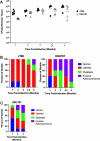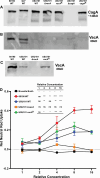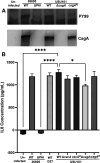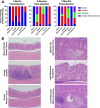A unique Helicobacter pylori strain to study gastric cancer development
- PMID: 39641575
- PMCID: PMC11705839
- DOI: 10.1128/spectrum.02163-24
A unique Helicobacter pylori strain to study gastric cancer development
Abstract
Helicobacter pylori colonizes a majority of the human population worldwide and can trigger development of a variety of gastric diseases. Since the bacterium is classified as a carcinogen, elucidation of the characteristics of H. pylori that influence gastric carcinogenesis is a high priority. To this end, the Mongolian gerbil infection model has proven to be an important tool to study gastric cancer progression. However, only a small number of H. pylori strains have been evaluated in the gerbil model. Thus, to identify additional strains able to colonize and induce disease in this model, several H. pylori strains were used to infect Mongolian gerbils, and stomachs were harvested at multiple timepoints to assess colonization and gastric pathology. The USU101 strain reproducibly colonized Mongolian gerbils and induced gastric inflammation in the majority of the animals 1 month after infection. Adenocarcinoma or dysplasia was observed in the majority of gerbils by 2 months post-infection. To define the contribution of key virulence factors to this process, isogenic strains lacking cagA or vacA, along with restorant strains containing a wild-type (WT) copy of the genes, were studied. The ΔcagA USU101 strain colonized gerbils at levels similar to WT, but did not induce comparable levels of inflammation or disease. In contrast, the ΔvacA USU101 strain did not colonize gerbils, and the stomach pathology resembled that of the mock-infected animals. The restorant USU101 strains expressed the CagA and VacA proteins in vitro, and in vivo experiments with Mongolian gerbils showed a restoration of colonization levels and inflammation scores comparable to those observed in WT USU101. Our studies indicate that the USU101 strain is a valuable tool to study H. pylori-induced disease.IMPORTANCEGastric cancer is the fifth leading cause of cancer-related death globally; the majority of gastric cancers are associated with Helicobacter pylori infection. Infection of Mongolian gerbils with H. pylori has been shown to result in induction of gastric cancer, but few H. pylori strains have been studied in this model; this limits our ability to fully understand gastric cancer pathogenesis in humans because H. pylori strains are notoriously heterogenous. Our studies reveal that USU101 represents a unique H. pylori strain that can be added to our repertoire of strains to study gastric cancer development in the Mongolian gerbil model.
Keywords: CagA; H. pylori; Mongolian gerbils; VacA; gastric adenocarcinoma.
Conflict of interest statement
The authors declare no conflict of interest.
Figures






References
MeSH terms
Substances
Grants and funding
LinkOut - more resources
Full Text Sources
Medical

